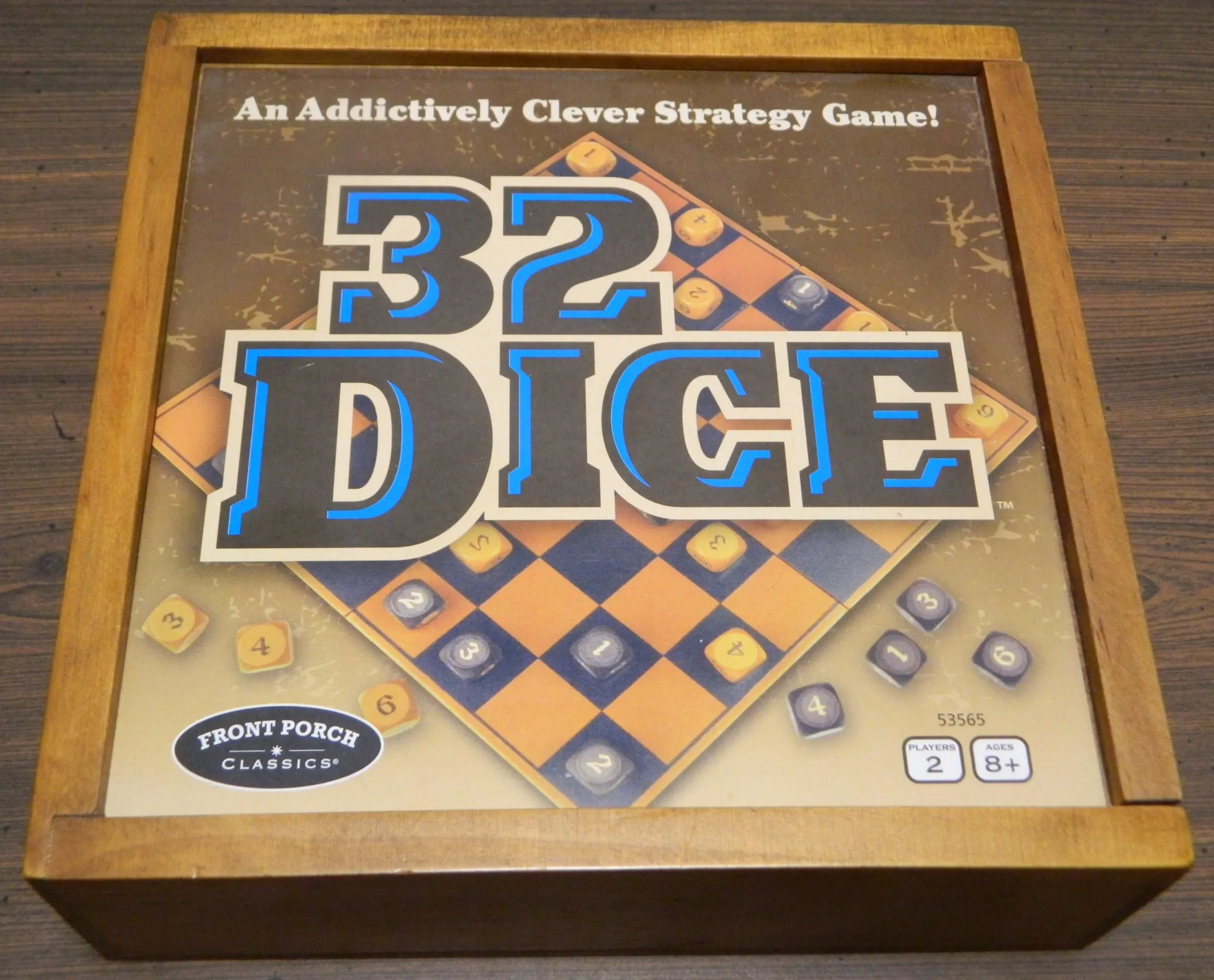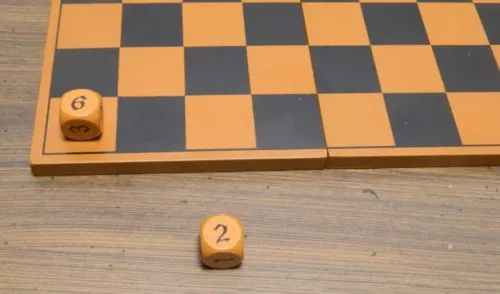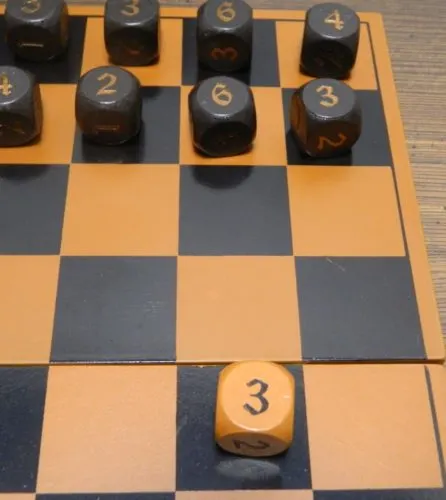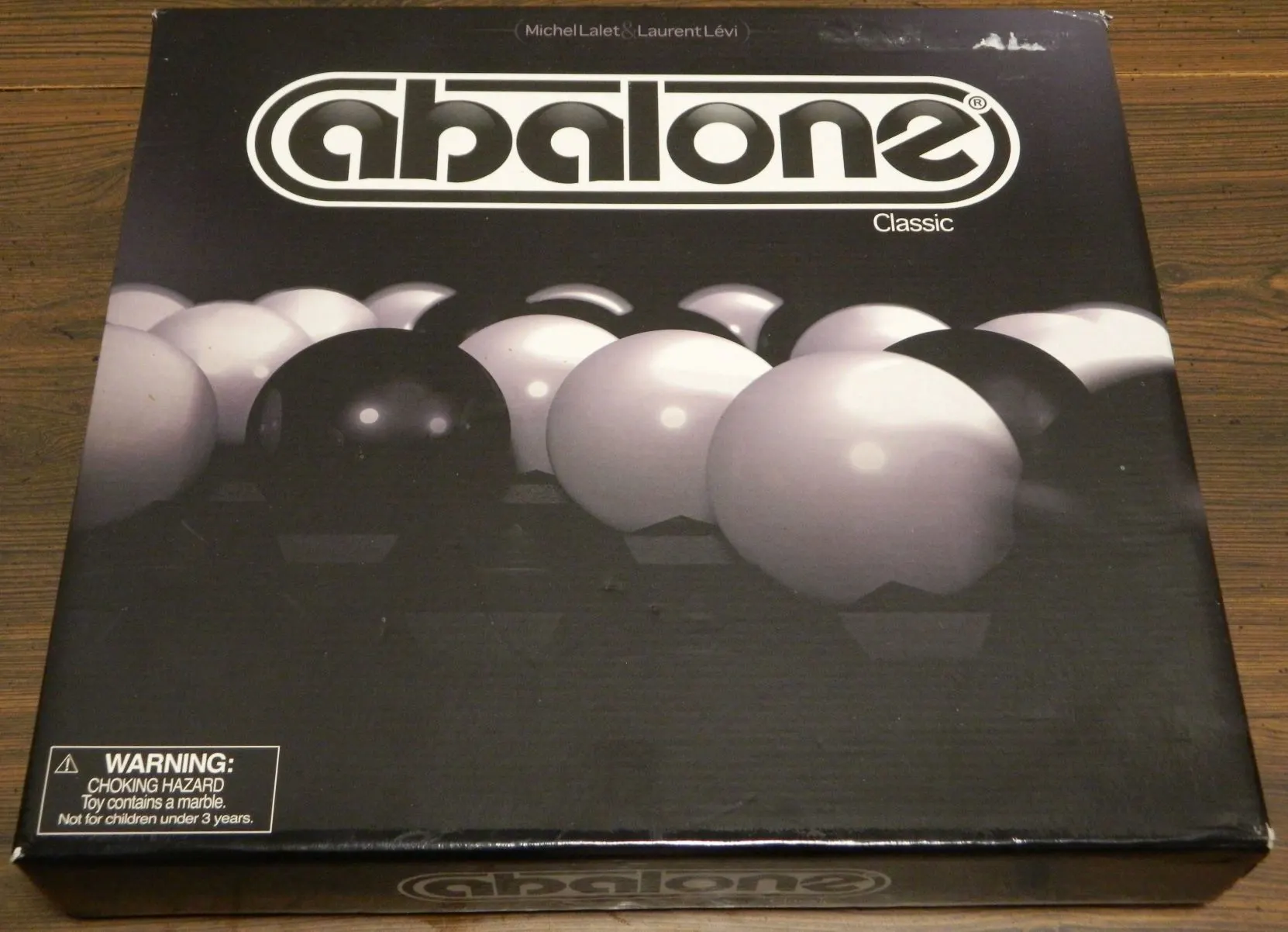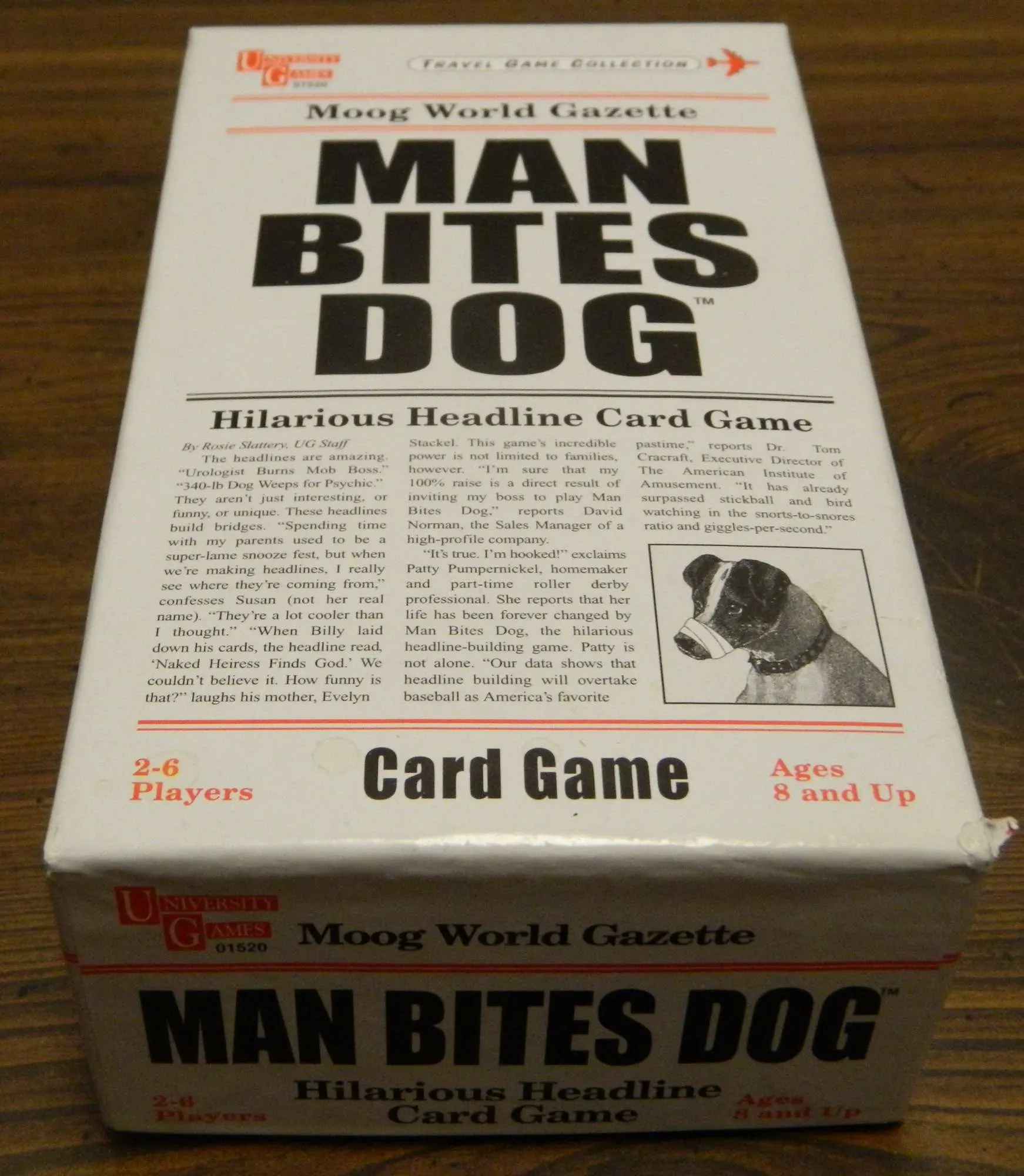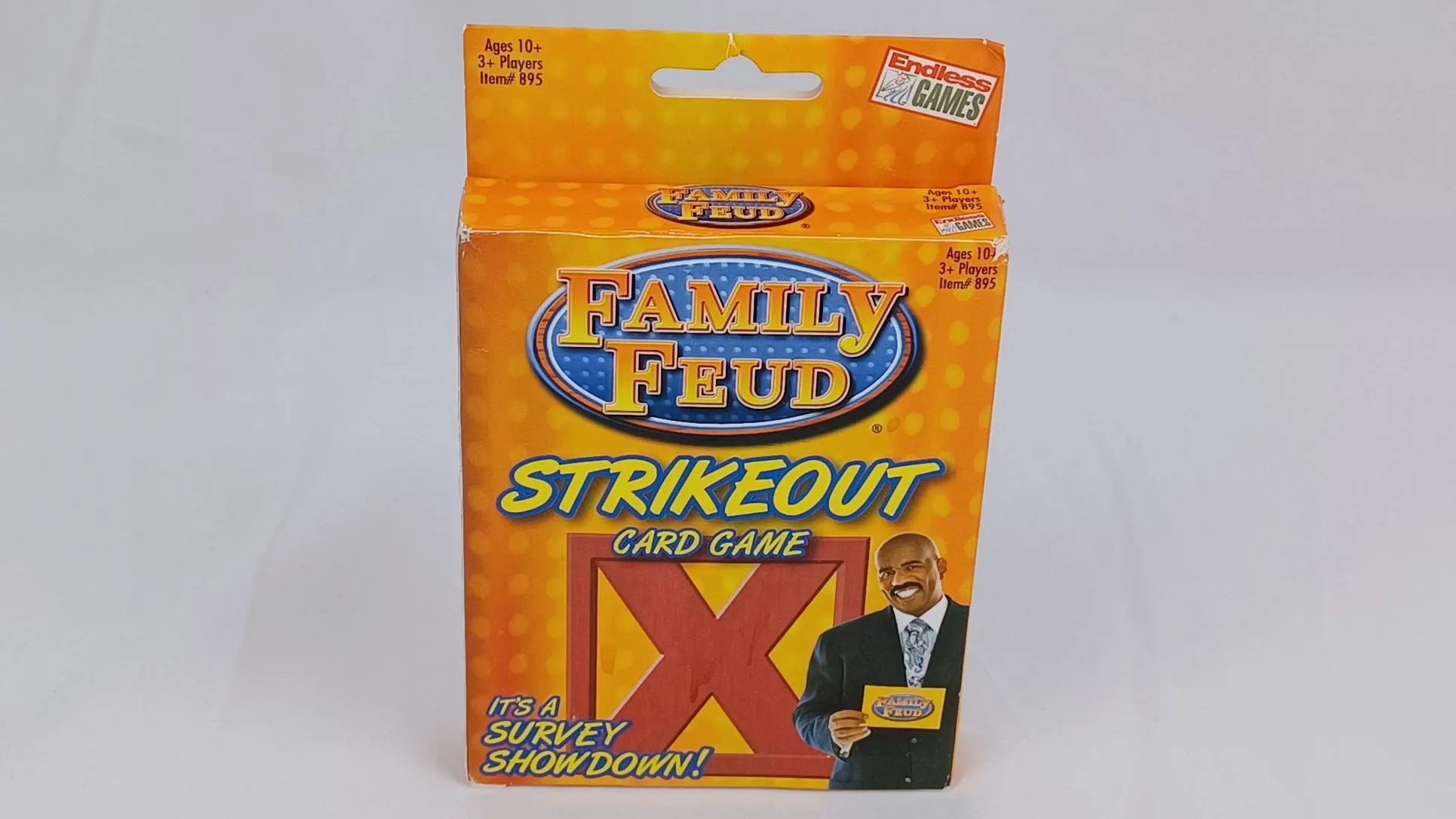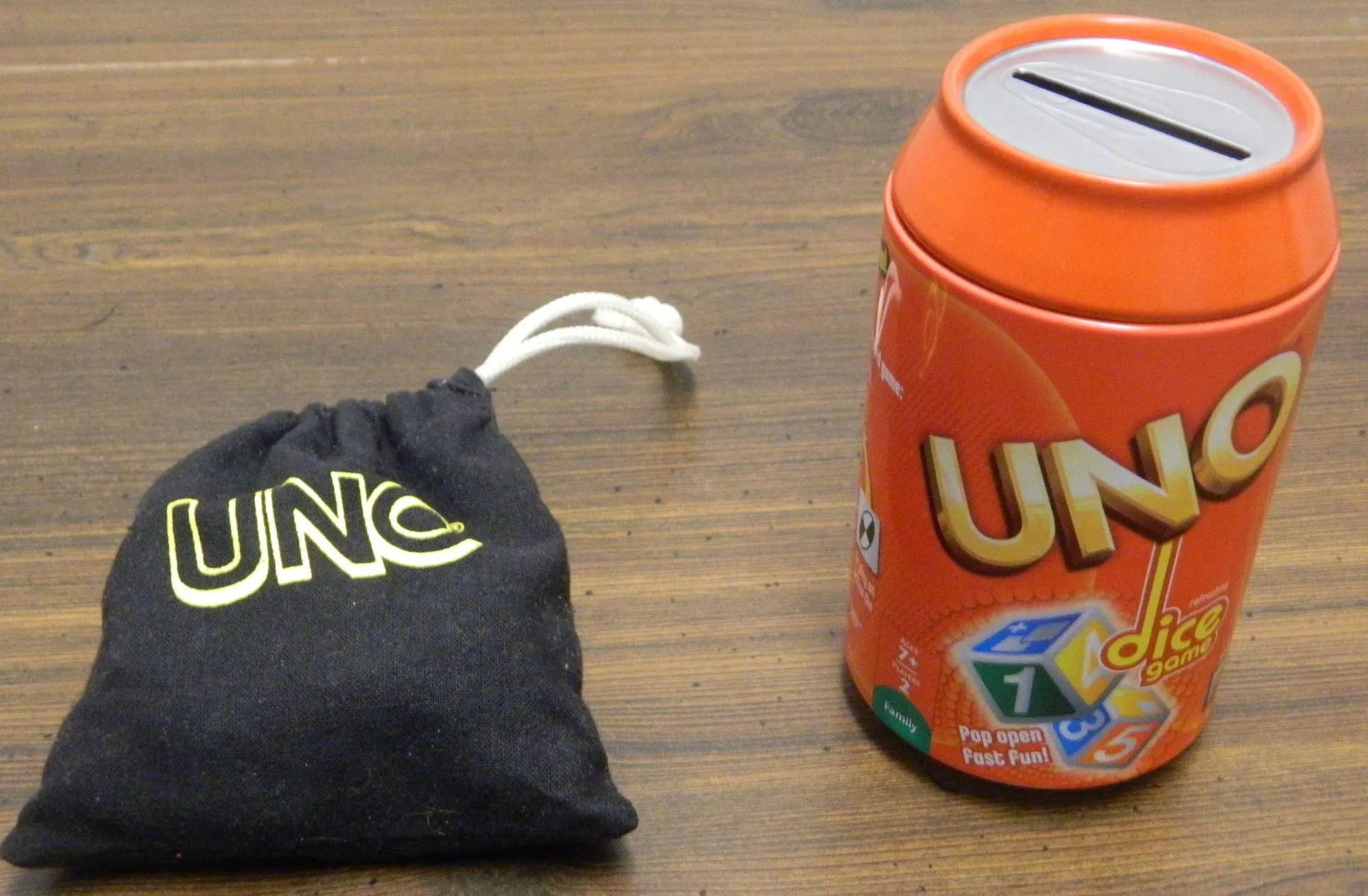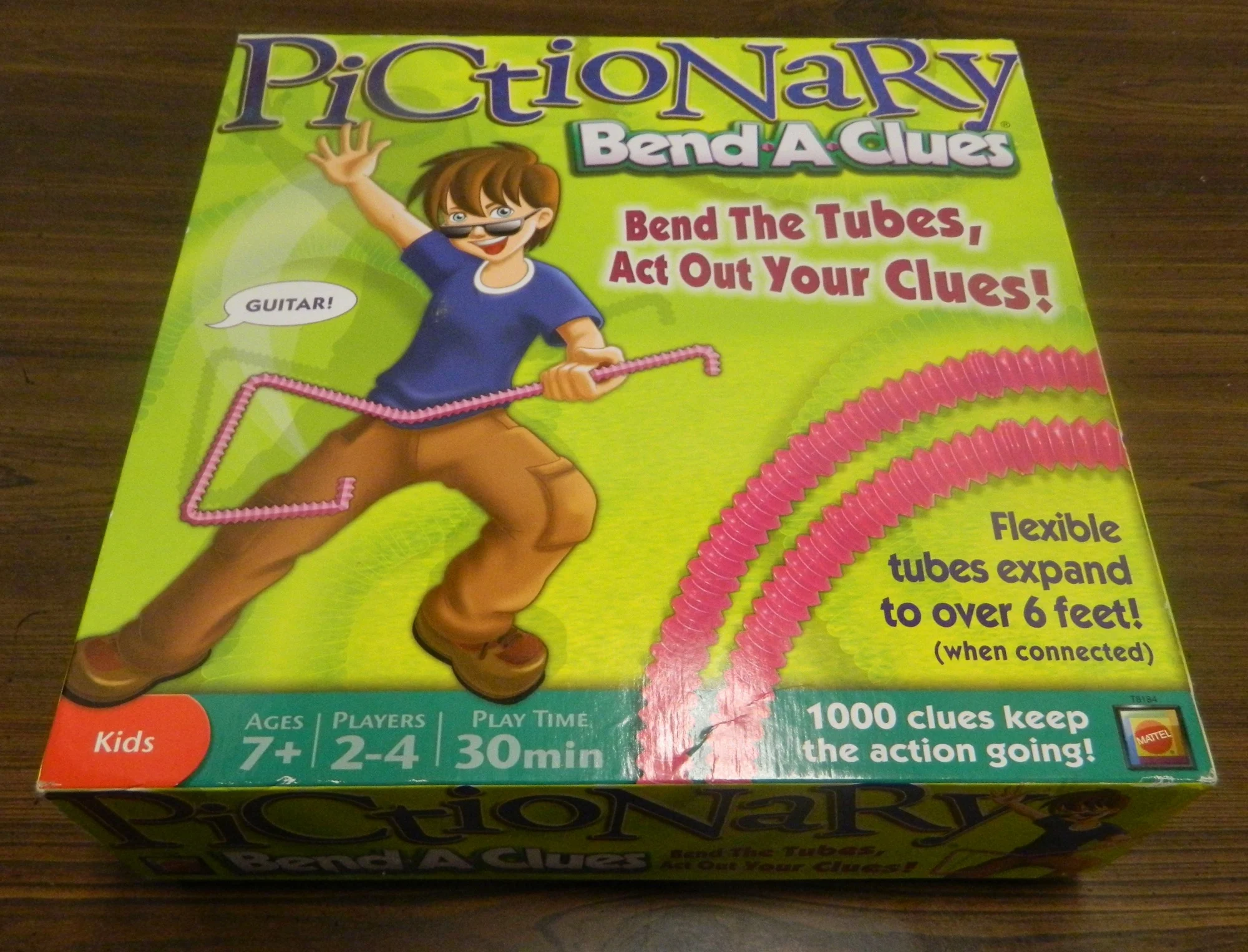Probably the most popular abstract strategy game of all time is Chess. The game has only been played for hundreds of years, and yet it remains popular to this day. One of the reasons the game is so popular is that there are so many strategic options where the game is unsolvable. With how popular Chess is there have been quite a few games that have tried to recreate the experience with a twist. Most just slightly tweak the rules of Chess while others are mostly just inspired by Chess. Today I am looking at 32 Dice. At first it might not look much like Chess outside of the gameboard. When you play the game though you can really see the similarities between the two games. While I am not a huge fan of Chess, I am interested in trying out games that might improve upon the formula. 32 Dice has a lot going for it, and yet fails to be anything more than another generic abstract strategy game.
How to Play 32 Dice
Setup
- Each player sits on one side of the board. They will choose a color and take all of the corresponding dice.
- Players will roll their dice one at a time. The side they roll will be the side that is placed face up on the gameboard. Beginning with the space in their back left corner, players will place each dice they roll on the next available space in the back row. They will then start the second row on the left side.
- The player with the most sixes face up will start the game. If there is a tie, the player with the most fives will start the game (and so on).
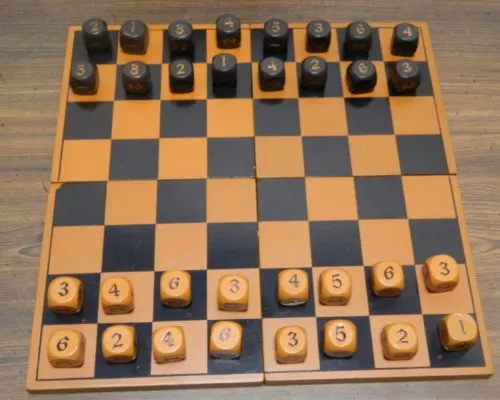
All of the dice have been setup for the game. As the black player has two sixes while the brown player has four sixes, the brown player will start the game.
Playing the Game
On a player’s turn they can choose one of two options.
First they can move one of their dice the number of spaces shown on the top face of the die. The die can be moved in any direction, but you must move the piece straight (you cannot change directions). When moving a die you also can’t move it through any or your own or the other player’s dice.
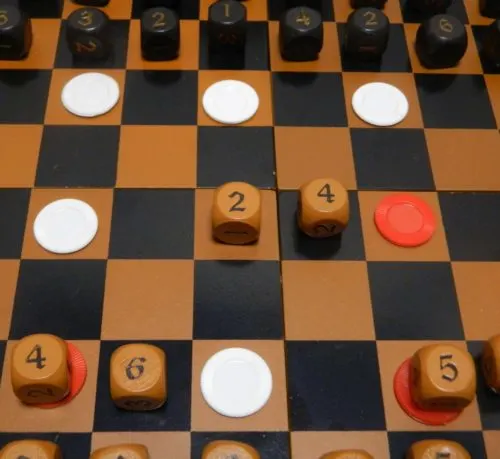
The brown player has decided to move their 2 dice. They can move it to any of the spaces with a white chip on it. They can’t move it to the spot to the right with the red chip as they can’t move through the four die. They can’t move it to the other two spaces with a red chip because they are occupied by some of their other dice.
If you can move your die onto the same space as a die occupied by the other player (by exact count), the other player’s die is removed from the game.
Instead of moving a die the player can change the number on one of their dice. They can turn the die to any side except for the side that is currently face down.
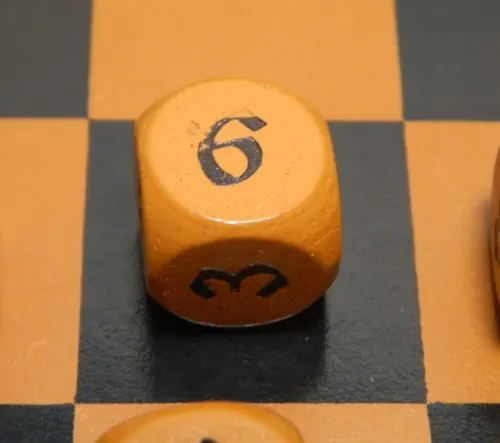
This player has decided to change the face up number on this die. They can change it to any number except for one as that is the current face down side.
Winning the Game
When a player gets one of their dice to the other side of the board, the other player has one turn to remove the die from the gameboard. If they successfully remove the die, the game continues.
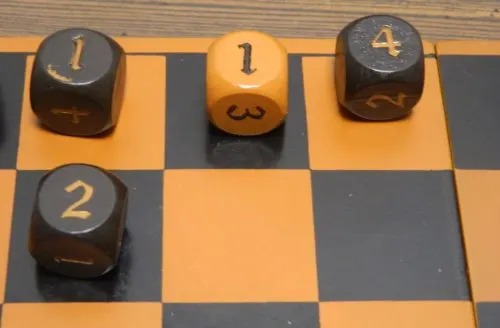
The brown die has made it to the other side of the gameboard. The other player can use their one die on the left to capture the brown die before the player wins the game.
If they can’t remove the die, the player controlling the die will win the game.
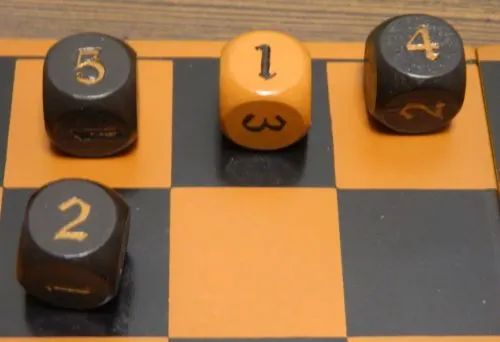
The brown player has reached the other side of the board. The black player has no way of capturing the die this turn so the brown player will win the game.
My Thoughts on 32 Dice
While there are obvious differences between 32 Dice and Chess, while playing 32 Dice it had a distinct Chess vibe to it. You move dice around the gameboard in order to capture the other player’s dice. This feels a lot like capturing pieces in Chess. Instead of trying to checkmate the other player’s king, you just have to get one of your pieces to the other player’s back row and not have it captured for a turn. This seems quite a bit different than Chess, and yet it reminds you a lot of it.
The biggest area where 32 Dice differs from Chess is how you move your pieces. Instead of using pieces with predetermined move patterns, you will use the dice to move. How far the dice can move is determined by the face up number. For example a one die can only move one space while a six dice has to move six spaces. Pieces can move in any direction, but they must move their full number and they can’t move through other dice. On the surface this is a clever idea. Every number has it own positives and negatives. High numbers are good since they let you move further, but they have less maneuverability. Low numbers can’t move very far, but they give you more options in how you move them. Middle numbers are a good mixture of both.
The number movement mechanic is improved by the fact that you can use a turn to change the number on one of your dice. If the number on one of your dice isn’t very helpful in its current position, you can change it. An even better use is to move a die, change the number, and then move the die again. While you have to move in a straight path, the ability to change the die’s value between movements gives you a lot of flexibility in how you move your pieces. With the movement flexibility I thought the game would have quite a bit of strategy.
In some ways 32 Dice has quite a bit of strategy, and in other ways the game’s strategy is a little limited (more on this later). Basically the goal in the game is to get one of your pieces to the other player’s back row. There are a couple different ways you could do this. First you could just eliminate most of the other player’s dice so they can’t protect their back row. In a long protracted game this is probably the best strategy. A more efficient strategy is to find a weakness in the other player’s line. You are looking for an area where the player doesn’t have any low dice. Basically you want to get to the back row in an area where there isn’t a one die nearby. If you can get to the back row and there are no ones nearby, the other player won’t be able to stop you in time and you will win the game.
On the surface 32 Dice has a lot going for it. The game potentially has a lot of strategy. It is also really easy to play. Younger children aren’t going to understand all of the strategy. As long as they can count to six and follow the game’s simple rules though, they should have no problems playing the game. The game does a really good job combining accessible gameplay with quite a bit of strategy. The game also plays pretty quickly as I would say that most games will only take around 15-20 minutes. When you add in the interesting premise, 32 Dice has all the makings of a good abstract strategy game.
In practice though it just feels like there is something missing from the game. The game feels like it would have a lot of strategy, but when playing the game it feels like you are basically doing the same things over and over again. If you put in enough time you may be able to figure out some other strategies, but at least initially it feels like there is basically one way to approach the game. You find a weakness in the other player’s line and attack it. Unless the other player had terrible luck with their initial rolls, you have to rely on them not noticing what you are planning to do. This is because they will have at least one turn to react to any game winning move you make.
Another problem with 32 Dice is that for an abstract game it relies on quite a bit of luck. Your initial dice rolls can have a pretty big impact on the outcome of the game. You can use your turns to change the dice you rolled, but that forces you to waste a turn. While you waste a turn turning a die, the other player could use the dice they initially rolled to take one of your dice. Every number has their own positives and negatives, but there are starting locations that are better for some numbers than others. For example the more fives you can get in your front row the better. The reason why fives are valuable in the front row is that they can take the die in front of them or on one of their diagonals without having to make any other moves. If the other player has no ones by the die you plan to take, you can take the die from the other player with no consequences. At the same time it is good to have a mix of large and small numbers in the back row so you can both attack and defend.
As the numbers you roll can have a big impact on the game, I honestly don’t know why the game forces you to place the dice in the order you roll them. I think a much better idea would have been to let players choose which space (in the back two rolls) that they would like to place each dice they roll. This wouldn’t have gotten rid of all of the game’s luck, but it would have introduced more strategy to the game. Players could have formed a strategy based on where they placed certain numbers. I honestly think this small change to the rules could have improved the game quite a bit.
Honestly all of these problems lead to 32 Dice being kind of boring. It is hard to put my finger on exactly what is wrong with the game, but it just isn’t that fun to play. Most of the game seems to come down to: I take your piece, you take my piece. The game feels like it has quite a bit of strategy, but in practice it doesn’t really pan out. It feels like your fate in the game comes down to two things. First the luck which I just mentioned. Otherwise most of the strategy in the game comes down to another player not noticing what you are trying to do. If you can make a key move and the other player doesn’t know why you are making it, you have a good chance of winning the game.
The biggest problem with the game though is that there really isn’t any need for the actual game. Basically the game consists of a 8 x 8 gameboard and 16 dice of two different colors. I will say the components are pretty good as the wood dice and gameboard look pretty good. It was a little hard to see the numbers on the black dice though. Outside of having nice components there is no reason to own 32 Dice. Just grab a Chess/Checkers board and 16 dice of two different colors. That is all you need to make your own version of the game. With such basic components I am curious if 32 dice was a public domain game that University Games repackaged into 32 dice.
Should You Buy 32 Dice?
I have mixed feelings about 32 Dice. There are a lot of things I liked about the game. The premise is interesting as you use dice for movement. This means that every piece can have different movement options open to them. When you factor in that you can change the face of a die, this opens up even more movement options. I thought the game was going to have a lot of strategic options. The game is also easy and quick to play. The problem is that in action the mechanics don’t work as well as you would expect. The game seems to have some pretty set in stone strategies that are best for winning the game. The game also relies on a lot of luck as your initial roll is going to play a big role in determining your chances of winning the game. To top it all off you can easily just make your own copy of the game if you have 16 dice of two different colors and a Chess/Checkers board.
While the two games seem quite a bit different, I think your feelings on Chess will probably translate to 32 Dice. If you hate Chess I can’t see you liking 32 Dice as it is pretty similar. If you really like Chess I see you liking 32 Dice as it has a very familiar feel to it. People like me that neither love or hate Chess will have a much more difficult decision. I thought the game was okay but wasn’t anything special. I can see some people not really liking 32 Dice and others liking it quite a bit. For these people I would consider making your own version of the game and trying it before purchasing an official copy of the game.
If you would like to purchase 32 Dice you can find it online: Amazon, eBay

